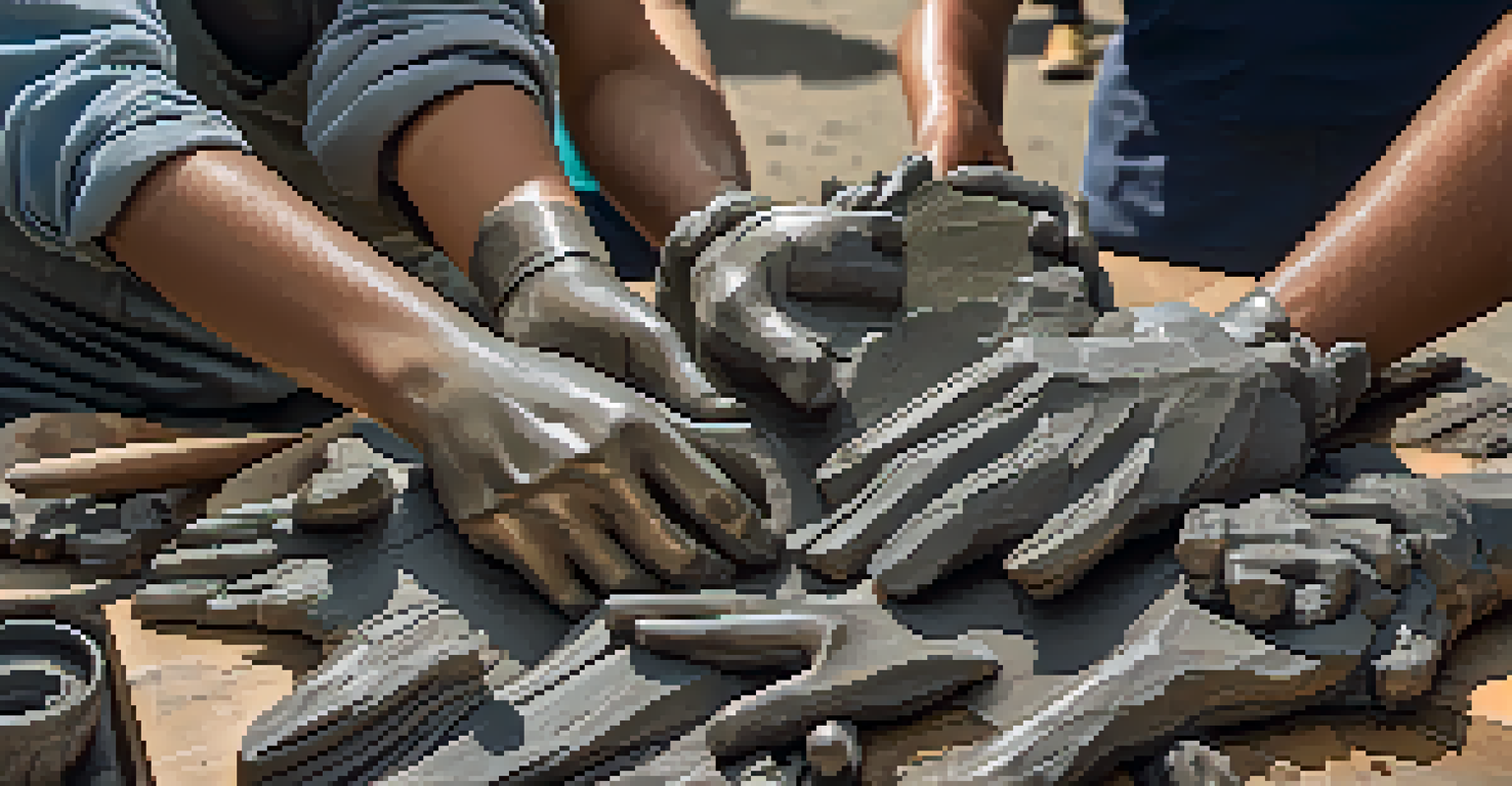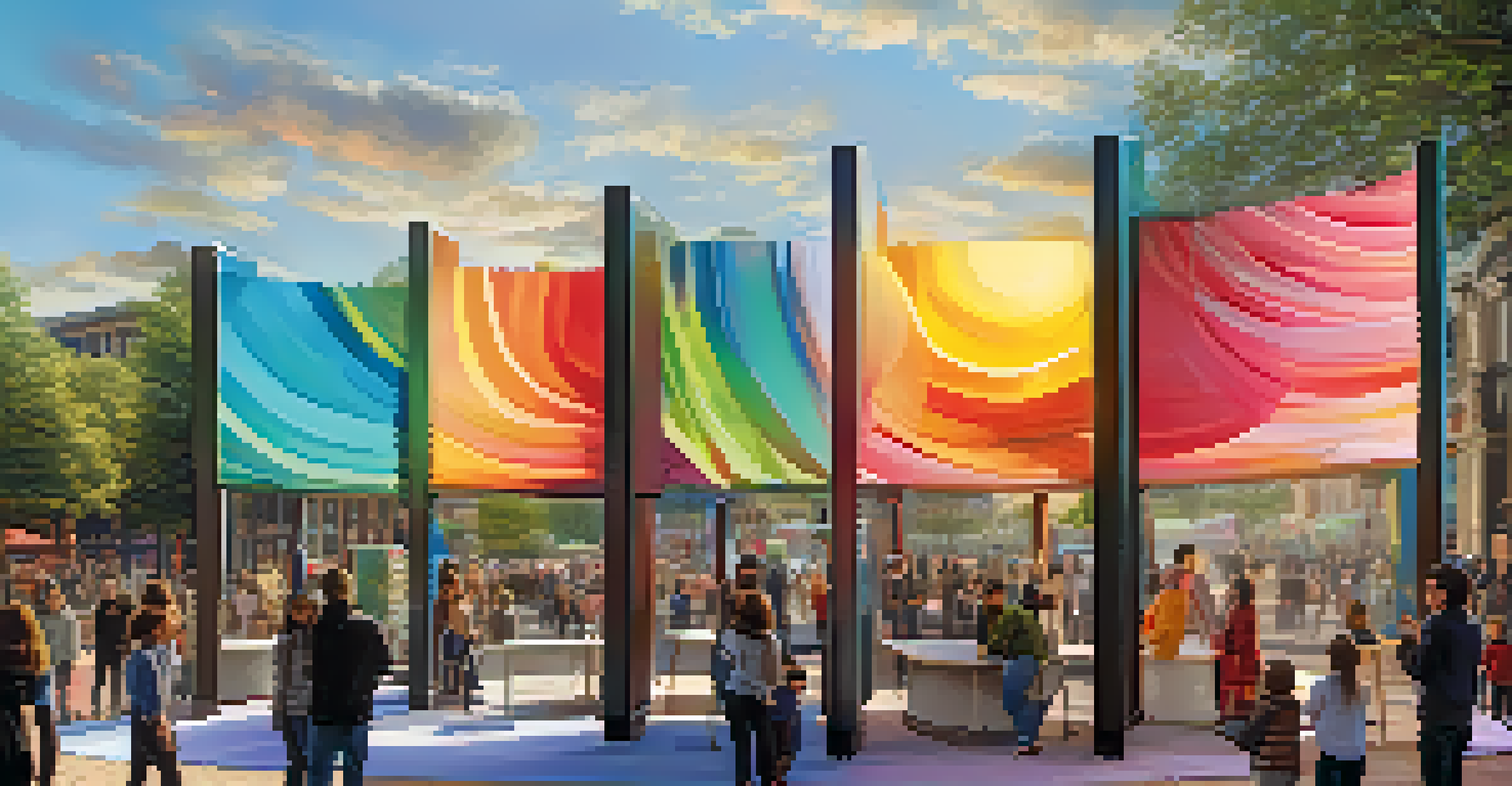Community Engagement: Collaborating on Public Art Projects

Understanding Community Engagement in Art Projects
Community engagement in art projects involves local individuals working together to create meaningful art. This collaboration can take many forms, from murals to sculptures, and often reflects the community's identity and values. When people come together, they not only share ideas but also foster a sense of belonging and ownership over their shared space.
Art is not freedom from discipline, but disciplined freedom.
Art has a unique ability to connect people, bridging gaps between diverse backgrounds and experiences. By involving community members in the artistic process, artists can ensure that the final product resonates with those who will experience it daily. This collaborative effort can lead to richer, more authentic artwork that speaks to the heart of the community.
Moreover, engaging locals in public art projects can enhance civic pride. Communities that see their voices reflected in public spaces are more likely to take care of and invest in those spaces, leading to a cycle of ongoing engagement and improvement.
The Benefits of Collaborating on Public Art Projects
Collaboration in public art projects brings numerous benefits, such as fostering creativity and encouraging teamwork. By pooling ideas and skills, community members can create art that is not only visually appealing but also imbued with collective meaning. This teamwork can spark innovation, as different perspectives blend to form unique artistic expressions.

Additionally, public art can serve as a catalyst for social change. When communities unite around a common project, they often address shared issues or celebrate their histories. This collective effort can raise awareness about important topics, making art a powerful tool for advocacy.
Community Art Enhances Local Identity
Collaborative art projects allow community members to express their identity and values, fostering a sense of belonging.
Lastly, these projects often lead to stronger community ties. As people work together, they build relationships and create networks of support that extend beyond the art project itself, fostering a sense of unity that can lead to future collaborative endeavors.
Examples of Successful Public Art Collaborations
Cities around the world have seen incredible transformations through community-led public art initiatives. For example, the 'Chicago Mural Movement' saw artists and locals come together to create vibrant murals that tell the stories of their neighborhoods. These artworks not only beautify the area but also serve as historical markers and conversation starters.
The best way to predict the future is to create it.
Another notable example is the 'Philadelphia Mural Arts Program,' which has involved thousands of residents in creating over 4,000 murals since its inception. This program has not only enhanced the city’s aesthetic but also provided job training and educational opportunities for participants, showcasing the multifaceted benefits of community engagement.
These examples illustrate that public art can serve various purposes, from beautification to storytelling and social change. They remind us that collaboration can lead to impactful results that resonate with the community at large.
How to Initiate a Public Art Project in Your Community
Starting a public art project requires a clear vision and a commitment to community involvement. Begin by gathering a group of interested individuals to brainstorm ideas and assess the community's needs. Consider hosting workshops or meetings to engage residents and gather input, ensuring that everyone feels included in the process.
Once you have a direction, it's essential to seek funding and support, whether through grants, local businesses, or crowdfunding. Be sure to communicate the project's goals and benefits to potential sponsors, showing how their investment will positively impact the community. Transparency and collaboration will be key in building trust and support.
Public Art Drives Social Change
Engaging communities in public art initiatives can raise awareness about pressing social issues and promote advocacy.
Finally, as the project unfolds, maintain open lines of communication with community members. Keep them informed about progress, and encourage ongoing participation. This inclusive approach will help cultivate enthusiasm and pride, ensuring the project is a true reflection of the community's collective spirit.
Challenges in Community Art Collaborations
While community art projects can be rewarding, they are not without challenges. One common hurdle is managing differing opinions and visions within the group. It’s essential to foster a culture of open dialogue, where all ideas are valued, and conflicts can be addressed constructively.
Another challenge is securing funding and resources. Public art projects often require financial backing for materials, permits, and other expenses. Creative strategies like partnering with local businesses or applying for grants can help overcome this obstacle, but it requires persistence and organization.
Additionally, ensuring the project's longevity can be difficult. Once the artwork is complete, ongoing maintenance and community engagement are crucial for its preservation. Establishing a plan for upkeep and involving residents in its care can help sustain the art and the relationships built during the project.
The Role of Local Government in Public Art Projects
Local governments play a vital role in facilitating public art projects by providing support, funding, and resources. They can help streamline the permitting process, making it easier for communities to bring their artistic visions to life. By championing public art, local officials can demonstrate their commitment to enhancing the community's cultural landscape.
Moreover, governments can help foster partnerships between artists and community organizations. By acting as a bridge, they can connect resources and expertise, ensuring that projects are well-planned and executed. This collaboration can lead to more successful outcomes and strengthened community ties.
Local Governments Support Art Projects
Local governments play a crucial role in facilitating public art by providing support, funding, and resources to enhance community culture.
Additionally, local governments can implement policies that encourage public art, such as allocating a percentage of city budgets for art projects or creating public art programs. These initiatives not only promote creativity but also enhance community identity and pride, ultimately benefiting residents and visitors alike.
The Future of Community Engagement in Public Art
As communities continue to evolve, so too will the approach to public art projects. The integration of technology, for instance, is becoming increasingly popular, allowing for interactive installations that engage audiences in new ways. This evolution opens up exciting avenues for collaboration and creativity, inviting even more voices to participate in the artistic process.
Moreover, as social issues gain prominence, public art projects may increasingly serve as platforms for advocacy and dialogue. Communities can use art to address pressing concerns, fostering conversations that lead to meaningful change. This trend highlights the importance of inclusivity and representation in the arts.

Ultimately, the future of community engagement in public art promises to be dynamic and collaborative. By continuing to prioritize local voices and shared experiences, communities can create art that not only beautifies their surroundings but also strengthens their bonds and enriches their collective narrative.